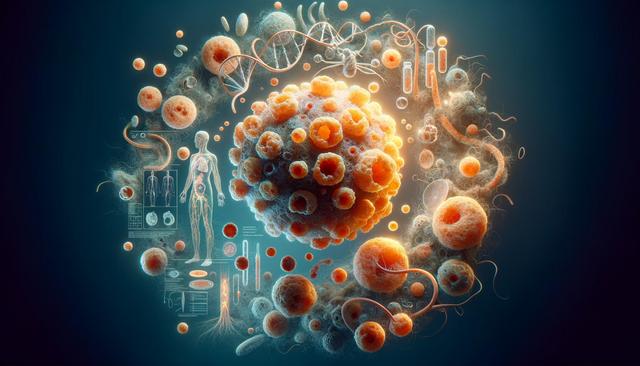What is Amyloidosis?
Amyloidosis is a group of diseases caused by the abnormal buildup of amyloid proteins in tissues and organs. These proteins are normally produced in the bone marrow and can deposit in any part of the body. When these abnormal proteins accumulate, they can interfere with the normal function of the affected organs. Understanding what is amyloidosis is crucial because early detection can greatly influence outcomes. This condition can be systemic, affecting multiple organs, or localized, impacting just one area. The type of amyloidosis a person has depends on the protein involved and where it builds up.
There are several types of amyloidosis, including AL (primary), AA (secondary), and hereditary forms. AL amyloidosis is the most common in developed countries and is linked to abnormalities in plasma cells. AA amyloidosis occurs due to chronic infections or inflammatory diseases. Hereditary amyloidosis is caused by genetic mutations and is usually passed down through families. Each type varies in progression and symptoms, making diagnosis a complex process.
Amyloidosis Warning Signs to Watch
Recognizing amyloidosis warning signs can be challenging because they are often subtle and resemble other health issues. However, paying attention to these early symptoms is key. Common warning signs include:
- Unexplained weight loss
- Fatigue and weakness
- Swelling in the legs, ankles, or feet
- Shortness of breath during minimal activity
- Numbness or tingling in the hands or feet
Since amyloidosis can affect many organs, symptoms can vary widely depending on which part of the body is involved. For example, if the heart is affected, it may lead to heart failure. If the kidneys are involved, it could result in nephrotic syndrome. Recognizing these warning signs early and seeking medical attention can help manage the condition more effectively.
Common Amyloidosis Symptoms
The spectrum of amyloidosis symptoms is broad and depends heavily on the organs affected. The symptoms often develop gradually, which can delay diagnosis. Some of the most frequently reported symptoms include:
- Severe fatigue
- Enlarged tongue (macroglossia)
- Bruising around the eyes (also known as raccoon eyes)
- Joint pain or stiffness
- Irregular heartbeat or palpitations
As the disease progresses, symptoms can become more pronounced and debilitating. In some cases, individuals may experience gastrointestinal issues such as diarrhea or constipation, and in others, liver enlargement. Because these symptoms overlap with many other conditions, it’s important to consider amyloidosis as a potential diagnosis when multiple systems of the body are involved without a clear cause.
Understanding Skin Manifestations
Although internal symptoms are more common, amyloidosis can also present with visible skin changes. These skin manifestations can provide important clues for diagnosis. Searching for amyloidosis skin pictures might reveal typical signs such as:
- Purplish patches around the eyes
- Waxy, thickened skin
- Easy bruising, especially around the neck and face
- Small, raised bumps or nodules
Dermatological signs are often overlooked but can be significant indicators of systemic amyloidosis, especially when they appear alongside other symptoms. If unusual skin changes appear without an obvious cause, especially in combination with fatigue or swelling, it’s advisable to consult a healthcare professional. These skin changes may be confirmed through a biopsy, which can also help identify the type of amyloid protein involved.
Diagnosis and Management Options
Diagnosing amyloidosis involves a combination of medical history, physical examination, laboratory tests, and imaging studies. A definitive diagnosis often requires a tissue biopsy, where a sample is examined for amyloid deposits. Once diagnosed, the next step is to determine the type and extent of organ involvement. This helps in tailoring a suitable treatment plan.
Treatment options vary depending on the type of amyloidosis. Common approaches include:
- Medications to reduce amyloid production
- Chemotherapy for AL amyloidosis
- Anti-inflammatory drugs for AA type
- Supportive care to manage symptoms
- Organ-specific treatments, such as dialysis for kidney failure
While there is no universal cure, early intervention can significantly improve quality of life. Ongoing monitoring and lifestyle adjustments are often part of long-term management. Patients are encouraged to work closely with a multidisciplinary medical team to address the complex needs of this condition.
Conclusion: Stay Informed and Vigilant
Amyloidosis is a rare but serious condition that demands awareness and timely medical attention. Understanding what is amyloidosis, recognizing the amyloidosis warning signs, and being aware of common amyloidosis symptoms can make a significant difference in early detection and treatment. In some cases, visible clues seen in amyloidosis skin pictures may even guide initial diagnosis. If you or someone you know is experiencing unexplained symptoms affecting multiple parts of the body, it may be worth discussing the possibility of amyloidosis with a healthcare provider. Staying informed is the first step toward better health outcomes.




Leave a Reply